#tibetan shrine room
Text
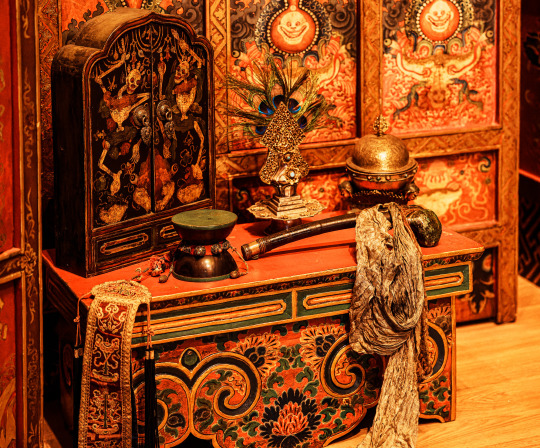
photo: David Castenson
#bhuddism#funerary objects#tibetan shrine room#national museum of asian art#photographers on tumblr#thigh bone trumpet#skull cup
102 notes
·
View notes
Photo
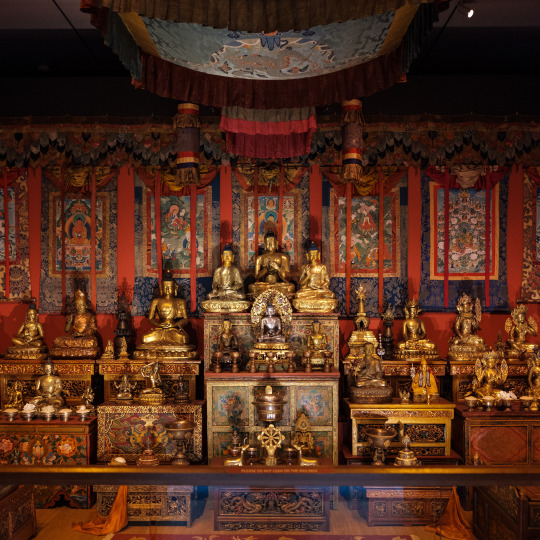
The Tibetan Buddhist Shrine Room
5 notes
·
View notes
Text
Dehradun Tour Package

Welcome to Dehradun Tour Package, Dehradun is the capital of the Indian state of Uttarakhand, near the Himalayan foothills. At its core is the 6-sided Ghanta Ghar clock tower. To the southwest is Paltan Bazaar, a busy shopping area. Just east is the Sikh temple Gurdwara Nanaksar, topped with ornate white and golden domes. In Clement Town to the city’s southwest, Mindrolling Monastery is a Tibetan Buddhist center with shrine rooms in its Great Stupa. We offer best Dehradun tour package on your budget.
Company Name : Nainital Tour Package
Phone : 08449464823
Address : Mall Road, Near Naina Devi Temple Nainital, Uttarakhand, 263001
#nainitaltourpackage#nainitaltour#nainitaltourtravel#nainitaltourandtravel#jimcorbetttourpackages#dehraduntourpackage#dehraduntour#dehraduntourtravel
0 notes
Text
Manali:- Couple’s Destination
India is a country that is filled with numerous monuments, temples, beaches, deserts and mountains. Be it solo, friends, family or couple – it is a country that is suited for all types of travelers. It has a lot to offer and especially to those who are looking for romantic destinations to visit for a honeymoon. There are plenty of romantic honeymoon destinations in India and no matter how many new places you visit, they are not the only ones India has to offer. Manali offers a great mix of stunning vistas and a magical atmosphere for a perfect romantic setting. Kullu Manali Honeymoon is a peaceful or exciting, romantic or adventurous and so on.
Places To Visit In Manali:-
Hadimba Temple:- This Temple is devoted to Hadimba Devi, who is the wife of Bhima(one of the Pandavas) from the Great Hindu Epic Mahabharata. Goddess Hadimba Devi is generously blessing and guiding the people of the region in Manali Honeymoon Packages. This Temple was built-in the 15th century by Raja Bahadur Singh. It is found in the cedar forests of Manali, it is the most sacred and holy shrine in Manali. It is built around a cave, the shrine is covered by four-tiered Pagoda roofs. It is because of the mythological belief and architecture which is one of a kind.
Club House:- Club House is an amazing amusement and adventure zone, which is one of the most popular attractions in Manali. It is located in the center of the city near the Mall road in Manali. Honeymoon Package For Manali offers comprehensive facilities that include a roller skating rink, an auditorium, billiards rooms, a library, a bar, and a restaurant. Placed on the banks of Manalsu Nallah (branch of Beas River), it has various indoor and outdoor game facilities. The Club house is managed by the Himachal Pradesh Tourism Development Corporation (HPTDC).
Tibetan Monastery:- It is a famous spot and holy Buddhist and Monastery of Manali indeed. It is located close to the Mall road of Manali. This temple has a large statue of Lord Buddha. The monastery is run by the local people who gather funds through donations. The unique feature of the monastery is the handicrafts of Tibetan artistry and the carpets that are woven and sold in the monastery. The architecture of the monastery represents the Tibetan style of architecture designed with hued frescoes. The statue of the Lord Buddha presides in the monastery. Explore the ancient monastery with Manali Couple Tour Package.
0 notes
Photo

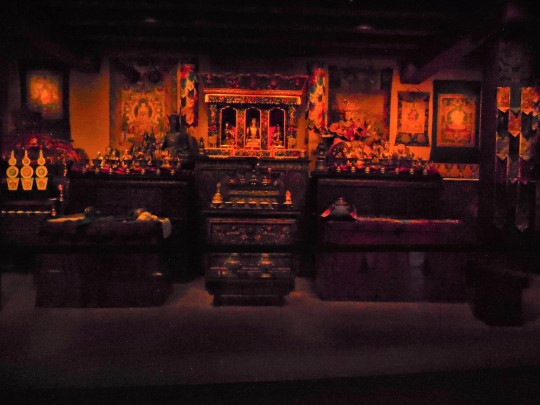
“Deep in my heart, I do believe/We shall overcome...” Nari Ward’s “Shoelace Art” was at the Rubin Museum, in Chelsea. Although this artwork pays homage to the civil rights marches, the museum is mostly dedicated to the Himalayan region. The Rubin is a favorite of mine. I especially appreciate their Tibetan Buddhist Shrine Room. The healing sights and sounds of this peaceful oasis can now be experienced on You Tube. “2 hours of chanting in a Tibetan Buddhist Shrine Room for meditation and concentration...” (Photo of “Shoelace Art” taken on October 18, 2019) (Photo of the Tibetan Buddhist Shrine Room taken on January 31, 2020)
#rubin museum of art#nari ward shoelace art#we shall overcome#tibetan buddhist shrine room#nyc museum#nyc photos
5 notes
·
View notes
Text

The Sakya Monastary holiday sale is Sunday, December 2, and worth checking out if you are into Tibetan crafts and artifacts.
At noon is one of the rare tours of the Shrine Room. This is the one of the only times that non-Temple members can see this space. This room is where the floor repair was courtesy of Bernardo Bertolucci and the film crew for Little Buddha. They filmed in the Shrine Room for that movie, while it was being built into what you see today.
1 note
·
View note
Video
Atmosphere of a Tibetan monastery .... Tharlam Monastery shrine room at break, light filtered by incense, with western Tibetan Buddhist student from South Africa reading, Bodhisattva Vows day, Sakya Lamdre, Boudhanath, Kathmandu, Nepal by Wonderlane
#Nepal#Lam Dre#3421#Tharlam Monastery#shrine room#break#western#Tibetan Buddhist#student#reading#Bodhisattva Vows#Bodhanath#Kathmandu#flowers#sun#incense#smoke#Tibetan#Buddhist#light#filtered#Tharlam#Monastery#shrine#room#images of the world#Boudha#religious#religion#spiritual
2 notes
·
View notes
Text
anyone else’s airbnb have a tibetan buddist shrine and a portrait with blood dripping down in the same room or nah
#this is the room im staying in#giving the bloody portrait a little goodnight kiss as we speak#there is also an imitation stone slab of part of the quran#just hanging there#im getting so many mixed messages#there is a gong in my window and if i peek out of the door i can see egyptian hieroglyphs#is this the twilight zone idk ive never seen it so i can’t say#osapost#shitpost
3 notes
·
View notes
Text
Thangtong Gyalpo: Mahasiddha and Builder of Bridges
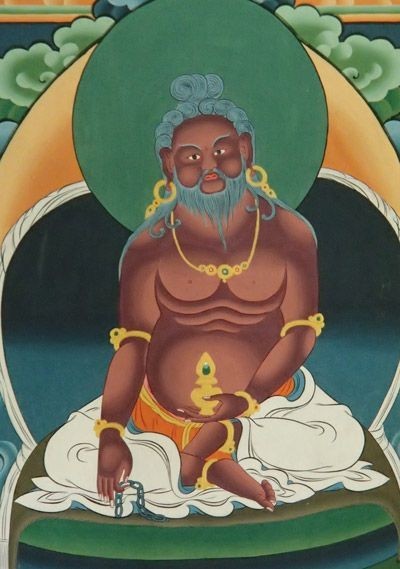
Thangtong Gyalpo: Mahasiddha and Builder of Bridges
“Visualize in front of you a vajra made of meteoric iron. At its center is Thangtong Gyalpo, 900 years old, very beautiful, with red rosy cheeks, dark red, healthy, with a big belly and muscles. But to symbolize the nonduality of youth and age he should have white hair, mustache and beard, a long white beard. He is the one who built Tibet’s bridges and also created the Tibetan operas that we know.”
— Dzongsar Khyentse Rinpoche
The 14th-century mahasiddha Thangtong Gyalpo was a busy man. His status in Tibetan and Bhutanese culture is unparalleled: He was a master of the highest Vajrayana teachings, in addition to displaying unparalleled skill as an architect, blacksmith, civil engineer, artist, writer of operas, and dispeller of epidemics. He is both a legend and a historical figure. Some records say that he was born in 1385 and instantly attained the age of 60 years. Most sources agree that he died when he was 125, having perfected secrets of longevity that practitioners can attain through supplication and prayer.
Rinpoche said in a recent teaching that Thangtong Gyalpo lived to be 900 years old, “but this 900 years old is very relative. Thangtong Gyalpo, depicted as an old man, with a white beard, nice white hair, really big, muscle-y, not frail — all of this has tendrel. Being a healthy old man brings the meaning of long life. The white beard means wise. So by visualizing, praying, and supplicating, it creates this tendrel for the practitioner to receive this blessing of longevity.”
Born in Ölpa Lhartse in upper Tsang, Tibet, the historical figure Thangtong was a unique mahasiddha both because of his tremendous realization and his engineering accomplishments. He established incredible engineering marvels under challenging circumstances and over difficult terrain. Imagine a larger-than-life man like John Henry (an American legend who made railway tunnels through mountains with his hammer and huge forearms faster than steam-powered machines) combined with the wisdom of Padmasambhava, sitting astride a horse that he’d ride into shrine rooms. He became known as “the madman of the empty land.” In some Tibetan texts, he is reported to have been seen feasting just as easily on a long-dead and rotting horse as on delicacies.
It was because of his madman looks that one ferryman refused him passage across water to a holy site, and from this experience Thangtong Gyalpo had a vision of iron-chain suspension bridges that any pilgrim could cross. To build such a bridge, he would need to learn metallurgy to create durable links, study engineering to span unpredictable rivers and deep gorges, and raise funds to buy the iron ore and pay for labor.
Thangtong Gyalpo developed a method of smelting iron to create enormous chain links that remain untarnished to this day. Many of the 58 suspension bridges that he built are still in use in Bhutan and Tibet. He opened the route through the land of Kongpo aborigines, where he obtained iron for his bridges and rights of passage for Tibetan pilgrims to visit the holy places in Tsari to the southeast of Dakpo, near the Indian border. Many practitioners pray to him when they are seeking strength and connections. He also designed and built many large and unusual stupas across Tibet and Bhutan, including the great Kumbum Chörten at Chung Riwoche, and established Gongchen, a Sakya monastery in Derge.
It is said that Thangtong Gyalpo used his skills as a performing artist to raise money for his projects. He established Tibet’s first dharma theater troupe, which performed operas, recited mantras, and told stories that were meant to subdue demons and teach sentient beings . Today, Bu chen (“Great Sons”) performers in Tibet consider Thangtong Gyalpo the founder of Tibetan opera. They often perform a sword dance that ends with breaking a stone to reenact Thangtong Gyalpo’s triumph over an epidemic-causing demon. After flying to Lhasa on a white-tailed eagle, he trapped the demon inside a stone that he carried into the marketplace and split open with a rock shaped like a ritual dagger.
Thangtong Gyalpo’s ability to eradicate sickness is also part of his legend. His prayers are considered to be effective against myriad adverse circumstances. Dzigar Kongtrul Rinpoche writes that Thangtong Gyalpo’s Refuge Prayer is one of the most powerful. “The Outer, Inner, and Secret Refuge Practice of the Mahasiddha Thangtong Gyalpo prayer is very helpful. I do it all the time, day and night, whenever there’s a need. It was given directly to Thangtong Gyalpo’s teacher by Avalokiteshvara himself for Thangtong Gyalpo to spread… I’ve given it to a few people to do, to transform their life circumstances and different difficulties and patterns, and it seems like it really has worked wonderfull
15 notes
·
View notes
Video
youtube
Art in Practice: Encountering the Buddha with the Philip Glass Ensemble
Smithsonian's National Museum of Asian Art
Immerse yourself in the hypnotic music of composer Philip Glass while exploring artworks from the exhibition Encountering the Buddha: Art and Practice Across Asia at the Smithsonian’s National Museum of Asian Art. With Glass’s mesmerizing music as the soundtrack, the film takes a contemplative look at Buddhist sculptures and paintings as well as the complete Tibetan shrine room at the heart of the exhibition. In an interview made for this film, Glass explores the many ways his music has been inspired by Buddhism and Tibetan culture. The Philip Glass Ensemble performs excerpts from several of his signature works, all filmed recently in New York for this project.
5 notes
·
View notes
Text
Giu Mummy of Lahaul-Spiti. It's 500 years old and the teeth are still prominent!!
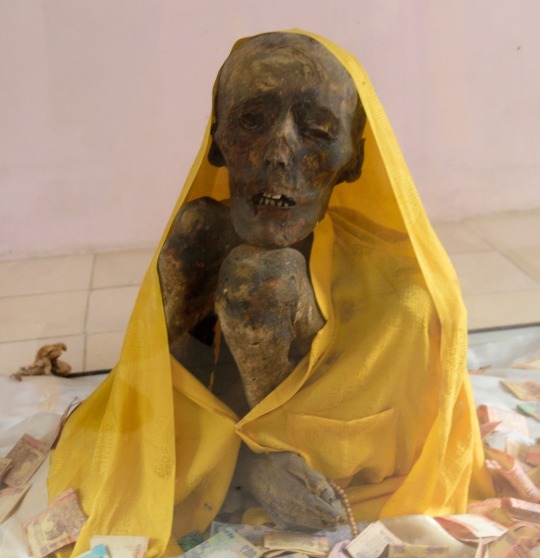

When you drive from Nako to Tabo, you cross a bridge over the Spiti River after Sumdo and take a detour of about 7 km to reach a small hamlet called Giu. This is an almost isolated habitation with no other village in view, but what makes it famous is over 500-years-old mummy of a Buddhist monk. On a small hillock just on the outskirts of the village in a small room, inside a glass cabin, lies the mummy of an old monk. The nails, teeth and hair of the mummy appear as if of a living person. There are many theories about how this monk’s body has remained in this state without decay and without the use of any chemicals for preservation. Apparently his body got buried beneath a glacier during an avalanche and remained there for hundreds of years till ITBP (Indo Tibetan Border Police) personnel found it during some road clearance project. It was then brought to Giu and placed here, and a small shrine was built around it. Another theory claims that the yogic posture in which the monk sits can self preserve the body. Whatever the case be, it is no less than a wonder to witness that how a human body has preserved itself for so many years without any decay or chemicals. When I visited, a new big temple was being built next to the existing shrine.
#giu mummy#lahaul spiti#himachalpictures#mummylife#awesome#photography#ancient#photographers on tumblr
1 note
·
View note
Note
Hey mun, it's ya girl with the Descendants OC. Assuming the Auradon government reviews the case that got Davos stuck on the Isle, then allows him to live in Auradon (& I do assume this), what do you imagine his home would be like? What kind of place might he be comfortable living in?

Ahhh this got totally buried, gomens!!!
So again, I know zilch about Descendants, but I can give you a notion of what Davos’s homestead in any verse would look like. It would be extremely consistent regardless of verse or crossover!
Davos’s homestead would be SIMPLE, CLEAN, and SPARSE. It would be open-concept in keeping with many of K’un-Lun’s interior spaces, and many traditional Asian home and temple designs (such as Shoin in Japan). It would convey an aura of self-control, and calm. All rooms would flow into each other without doors, save the bathroom. The lighting exists in the form of traditional Asian lanterns hung from the ceiling and wired with electricity. It’s low, ambient, warm, pensive.
The walls would be bare, made of stone, humble, with no indication of his high social status within K’un-Lun society, and only one plain wood-framed photograph of his home’s highest-rising temple as viewed from the Pass.
At dead center, on a modest shrine, out from which all the other open-space rooms radiate in rectangles from square modules, there would be a statue of the bodhisattva Guanyin (the manifestation of Buddha, before obtaining Enlightenment, who emblematizes Compassion).
Surrounding this would be two plain, air-purifying house plants, of equal size.
In the corner opposite the bathroom would be a kitchenette with all stainless steel appliances. Spotless, of course. Next to the stove, a beautiful hand-made ceramic tea set and several jars of rare, medicinal-grade looseleaf teas (particularly whites, yunnan blacks, oolongs, and matcha greens). Above the stove, square wooden compartments containing other eating utensils, and all-vegan dry foodstuffs. The modest refrigerator would contain vegan perishables. For any children (since this ask is about his daughter!), there would be a couple boxes of sweet and tasty organic mochis and basmati rices with veggie tots in the shape of dinosaurs ( :’) ).
He also has a bottle of the most delicious homemade soy sauce in all creation, and he will never ever tell you the recipe. His mother Priya invented it. It was one of the only warm, conventionally domestic things she ever taught him.
His bedroom is adjacent to the kitchen, between the two extreme spots of kitchen and bathroom. In it there is one mat on the floor, with absolutely no modern amenities or comforts, except a single blanket. For children, there is a far cozier sleeping bag stored in the closet, whatever is the child’s favorite color. There is also a tall water fountain with three tiers, austere and decorated only with very beautiful natural rocks. On a bedstand near it, there is a small traditional Tibetan’s child toy, a knitted red dragon, a gift from Priya when Davos was very young, and over that, carefully mounted on the wall, a worn red kite from his childhood, gifted to him by his father Lei Kung. The mark of Shou-Lao is printed at its center, to remind him that after a short while, play should cease and training resume. Davos was never allowed to escape the fate for which he was born, to become the Iron Fist. :( Not even when he was a young kid.
Across from his bedroom there is a training room. Making the home long enough for a small gym-sized training space is what accounts for all the other rooms being so open and spaced out. This room has a sliding door (also Shoin inspired, but way stronger than traditional rice paper) and extra lighting. It has a hanging punching bag, weights, stretching tools, running and workout gear, and mats. It has no decorations. It’s locked when any youngsters are around and Davos can’t give them his full focus.
bathroom, adjacent to bedroom and across from kitchen, has a clean functional toilet, a clean plain gray slate sink, a very small mirror (Davos never likes to look at his own reflection), and a modern stall shower with a glass door and with a silver showerhead and tile matching the sink.
There’s a landline phone but only people associated with his work (as a shifu) have the number. There is no television. There is wireless internet for his cell phone. It’s like, triple quadruple encrypted, lol.
2 notes
·
View notes
Text
Stay Luxury Resort in Dharmshala
Nature Bloom- Dharmshala
Surrounded by Cedar forests, Dharmshala is a poise and beautiful city reposing in Himachal Pradesh. The place is a home to Tibetan exiles and an ideal destination for peace seekers. The unblemished immaculate blue sky above your head and verdant valleys down your feet is something that provides calmness and piousness to one's soul and mind. Dharmshala is a secular city promoting peace and tranquility and achieves a huge amount of tourism every year. Dharmshala is the most attractive hill station in the Indian state of Himachal Pradesh.
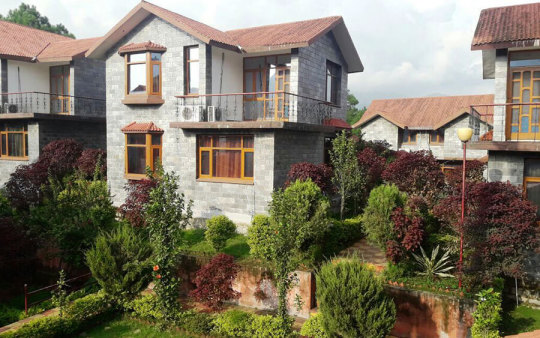
Mark your presence in the most luxury resort of Dharmshala
Dharmshala is the best place to plan your vacation amidst the relentlessly tweeting birds, alluring beauty of flowers and care-freely grooving trees with our best luxury resort in Dharmshala. Our resort helps you to get connected by the nature and the wildlife by providing a green and eco-friendly surrounding. We strive to make your connection with the nature and the earth more stronger than usual.
The versatility of the destination lies in the recreational activities provided, and Nature Bloom is all about providing the connection of nature to its esteemed guests by indulging them in different activities. From a warm and cordial welcome to accommodating in a luxury and capacious room, Nature Bloom is the best luxury resort in Dharmshala. The place is all surrounded by melancholy of nature and its belonging like melodious voice of birds, beautiful trail of green trees and sparkling steep drops of river.
Experience the blooming nature
Nature Bloom is all set to help you lead a cheerful and calm vacation away from all your jostling schedule. The view around the hotel is mesmerising and capable enough to provide calm and peace to rejuvenate your mind and soul. Nature Bloom is nestled amidst the poise and calm providing view like sparkling running waterfall, meldious chirping of birds, verdants and its trail all along your way.
We provide many recreational activities with having the impeccable and golden hues emanating sun above your head and fresh, foggy and hydrating grass below your feet while you enjoy the outdoor activities like fishing, rock climbing, trekking, paragliding and swimming. These activities are proven to be refreshing and rejuvenating for your mind and soul and would lead to calmness in one's behaviour. The most valuable stay to rely your vacation upon is the Nature Bloom as we provide the best and impeccable services by our indefatigable staff members who are ever present to cater your needs.
Reserve your stay at Nature Bloom
If you are planning to spend your vacation in Dharmshala, give us a chance to provide you with the best. Waking up to the blooming nature is like a reverie coming true as waterfalls, chirping of birds and green trails are not something usual in city! But with Nature Bloom you can enjoy the melancholy of nature and exuberant experiences Dharmshala upholds.
Surrounded by green pine trees Nature Bloom hotel and resort will help you lead a peaceful yet luxurious vacation. If you are looking for luxury hotels and resorts in Dharmshala then Nature Bloom is an ideal stay option as the place incorporates 1 BHK Cottage, 2 BHK Cottage, Deluxe Room, Exe. Suite Room, Family Suite Room all endowed with facilities like a fully furnished drawing room, in built bathroom incorporating all the modern facilities, tea maker so that you can enjoy your leisure time with your loved one by sipping a cup of tea in the attached balcony that opens to the alluring and eye grabbing beauty of Dhauladhar Mountains. The room and the drawing rooms are fully furnished with handcrafted furnitures embellishing the beauty of the resort and hotel.
Must visit places near Nature Bloom
Bajreshwari Temple
One of the 51 shaktipeeths resides here in the form of Pindi as Goddess Bajreshwari. It is said that the temple was built by the Pandvas during their exile back in at the time of Mahabharatha. The temple is reposing in the Kangra District of the Indian state Himachal Pradesh. The temple provides piousness and calmness to the mind and eventually to the body.
Baijnath Shiv Temple
Locating just 25 kilometres away from the resort Nature Bloom resides a revered shrine of Lord Shiva. The temple is nestled amongst the scenic view of mountain and alluring gardens. A single visit to the temple brings peace to mind and body.
Triund Trek
Beneath the mighty Dhauladhar ranges, is a scenic trail in Dharmshala away from hassle of city providing peace to mind and an adventurous trail to adventure seekers. Due to heavy snow the trek is almost close during the months of January and February but the rest of the months experience a panormic view alongside the mountains and verdant valleys.
Chamunda Temple
One of the renowed holy shrines of Hindus, Chamunda Devi Temple is a revered shrine in Kangra district of Himachal Pradesh. Also fabled as Chamunda Nandikeshwar Dham, this holy shrine is dedicated to goddess Durga and her mighty Shakti.
Kangra Fort
One of the most attractive part of the Kangra Fort is its ruins which make it a distinctive destination. Overlooking the Manjhi river and Ban Ganga river nestled ruins of Kangra Fort in the Kangra Valley.
McLeodganj
This place is fabled as one of the most attractive places in the world adn attracts a huge amount of tourism every year. The place promotes diversity and secularism as people practising different cultures can be found in the destination. McLeodganj is an ideal destination for peace seekers and uphold so many other attractive destinations to pay a visit at like Bhagsu Nag Temple has its own importance to be talked of.
Boost your mind and vacation with Nature Bloom!
Source Link : - https://naturebloomresortdharamshala.blogspot.com
#Resort in Dharamshala#best Resort in Dharamshala#luxury Resort in Dharamshala#best resorts to stay in dharamshala#luxury hotels and resorts in dharamshala
1 note
·
View note
Text
Trekking in Nepal
The best way to experience Nepal’s unbeatable combination of natural beauty and cultural richness is trekking in Nepal. Trekking does not mean mountain climbing but refers to walking on trails. While Trekking in Nepal Himalayas, There are many different route and difficulties. Some trekking is easy and more relaxing and some are more demanding and adventurous. Anyone with a pair of strong legs and adventurer spirit could enjoy the thrills of trekking in the foothills of Nepal Himalayas. Nepal's has world class alpine trekking, hard passes, tropical walking, and village hiking to enjoy as per desire. Trekking in Nepal is not just a walking or following the trails but be welcomed with the Nepalese culture, escaping from the human crowd and encouraging oneself by the mighty Himalayas.
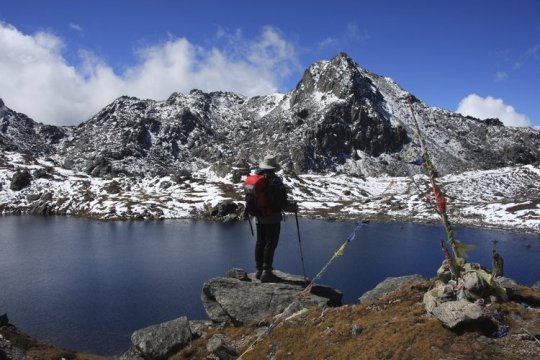
Types of Trekking:
TeaHouseTreks.
On a tea house trek, all your accommodation and food is catered by the local village Guest Houses along the trail. These days, although still local style houses, most of the accommodation is very adequate and hygienic with comfortable rooms for sleeping and a range of local and western dishes that can even rival the best restaurant in town!
OrganizedCampingTreks.
On a camping trek you will be fully self-sufficient enabling you to reach the remote areas of the mountains where even local villages are scarce. Accommodation for these treks are tents, and your food will be cooked on a kerosene stove by one of our chefs. Staff will carry all the necessary equipment, leaving you free to enjoy the scenery. Our camping treks are all environmentally aware. We choose our spots wisely, disturbing as little of the Eco system as possible. We take nothing but pictures and leave only footprints behind.
Trekking in the Himalaya
The Federal Democratic Republic Nepal is well known as one of the best destinations in the world for enjoying the real beauty of nature through trekking. The trail into the interior parts of the country follows ancient foot-trails which meander through scenic river-banks, intricately terraced fields and the forested ridges connecting picturesque hamlets and mountain villages. Trekkers can walk along the rough but beautiful trails or virgin tracks in the lap of green and friendly looking hills. The rhododendron-filled, green, dark and deep forests with different seasonal flowers blossoming can catch anyone's eye as can the scattered residential cottages, domestic and forest animals, variety of birds, both Hindus and Buddhist temples, mountains, breath-taking landscape, and above all warm greeting from smiling local people. The highly developed and well-defined trails have been used for centuries.Trekking with best trekking agency in Nepal is one of the good decision. It is possible at any time of the year depending on where one wishes to go. However, the most popular season are spring (February - May) and autumn (September-November). Even during the monsoon season (June- August), you can trek in the rain- shadow areas north of the Himalaya like Mustang, Upper Manang and Dolpo.
Annapurna Region
The diverse terrain and variety of cultures of the region north of Pokhara make each day's walk a different experience and make the area the most popular destination in the country. Four favorite treks, each with minimum of about one week and maximum of three week treks, to Kali-Gandaki basin include Manang region, Annapurna range, Jomsom and the Annapurna Sanctuary. Alpine meadows, moraines, glaciers and breathtaking views of the Annapurna range abound. The three hundred kilometer Annapurna Circuit combines the first two areas by crossing high altitude pass, Manang Thorang-La (5360 meters)and takes up to three weeks to complete.
Dhaulagiri
White Mountain, separated from the Annapurna region by Kali Gandaki gorge, the deepest gorge in the world, includes some fifteen peaks above 7000m. This region, considered to be one of the most remote places of the Federal Democratic Republic Nepal, has abundance of Himalayan peaks, hidden valleys, high passes and sweeping vistas. The Trans-Himalayan journey is quite, peaceful and full of adventure and excitement. Trekking in this area is relatively strenuous but trekkers willing to spend their holidays amid nature and natural surroundings full of peace and tranquility choose this "Off the beaten track" trekking destination.
Manaslu
The main journey here is around Manaslu, reaching north of the Himalayas and circling the great Manaslu-Himalchuli-Baudha massif. Since Manaslu is a special area for trekkers and was only officially opened from 1991 onwards for trekking, it needs special permits. Three-week complete treks will give you an exciting, adventurous and once in a lifetime experience.
The Everest Region
The areas around Khumbu is commonly called as the Everest Region. It is also known as the home of Sherpa people and the mysterious Yeti. This trek comprises not only the Everest Base Camp but also Namche Bazar, Lukla, Tyangboche and the whole Solukhumbu, which are at the lap of looming Mount Everest, the highest peak in the world and also the mount Ama Dablam . The trek to Khumbu area is not only famous for trekking and expedition but also for the Sherpa culture. One can enjoy and learn Sherpa culture very closely by visiting this region.
The complete trek starts from Jiri to Lukla. Flying to Lukla is the best option for those with limited time. Most of the flights depend on weather condition. However, the helicopter service and chartered flights are also available on request. The Everest Trek is one of the most thrilling adventure treks for excitement-seekers. There are several trekking routes within the Khumbu Region like Kalapatthar, Gokyo Lake, Everest Base Camp and Syangbochhe trek.
Jomsom to Mustang Trek
This trek starts from Pokhara and takes 150 km to reach Mustang. The new adventurous trek starts from Jomsom. The land is also covered with other glittering snow peaks like Nilgiri, Tukche and Muktinath, the famous shrine of Hindus. The trekking starts from Jomsom where there is an airstrip.
Mustang is 200 kilometers into the hinterland that constitutes mainly barren ridges, deep canyons, eroded cliffs and Moraine valleys. Its landscape is unrivaled for it has a stupendous wilderness, pristine scenery, snow capped peaks, spectacular 16th century monasteries and many other unique attractions. The view of wind swept Kali-Gandaki valley, vast spaces around Kagbeni and vast ridges that straggle high mountains provide a mind-blowing experience.
The Langtang - Helambhu
Gosaikunda region is easily accessible from Kathmandu. Each area in itself is a good choice for those with limited time. It offers many features that range from culture to adventure. In a week to ten days, any one can visit one of these areas by crossing high mountain passes. A three-week trip could cover all the three areas. The Himalayan views overall are not quite as spectacular as in the Annapurna or Khumbu region, but they remain unforgettably beautiful plus the trails are less crowded and the people are friendly and interesting. TheHelambhu-Gosainkunda trek takes one to Gosainkunda Lake - a sacred site for devotees of Hindu God Shiva. It is famous for both trekking a pilgrimage.
Dolpo Trek
The Dolpo region is the natural embodiment of high passes, rare flora and fauna, and sweeping vistas, which is enriched by the traditional Tibetan cultural heritage. This region, surrounded by Dhaulagiri and Tibet from south and north, respectively, is regarded as a blend of natural and cultural phenomena. It was opened in 1991 for trekking. This region lies on the north side of Himalayas, it is also a rain shadow area and the climatic situation of this place is same as that of Mustang. One of the longest treks in Nepal is Dolpo Trek that takes 34 days to complete. In this trek, the maximum elevation will be 4,530 m. to 5,115 m. and is one of the most arduous treks of the country. Kanchanjunga TrekLiterally the Kanchanjunga means crystal clear in Nepali while geographically the Kanchanjunga mountain is the second tallest in Nepal and the third tallest in the world after the Mt. Everest of Nepal and the K2 of Pakistan. The whole trekking areas in this region stretches through and around Arun River whose origin dates back to prehistoric period. The Arun valley is one of the most beautiful regions to trek in Nepal. Traveling around this part also gives an opportunity to enjoy and experience the traditional culture of Rai and Limbu, the native locals of this area. Trekking in this area is an adventure that is full of enthusiasm, excitement and above all, an unforgettable life time experience.
Gaurishanker
Gaurishanker Trek is another beautiful trek in Nepal where one can enjoy the beautiful scenery of majestic Himalayas including Rolwaling, Gaurishanker, Tashi Laptse, Dorje Lakpa. The trekking route is full of alpine forests including trees with blooming rhododendron flowers, the national flower of Nepal, and beautiful native villages.
#Trekking agency in Nepal#Trekking in Nepal#best tekking agency in nepal#trekking in nepal costs#trek in nepal#short trek nepal
1 note
·
View note
Text
Kalpa Kinnaur Package
Day 1: Delhi to Shimla| Chandigarh to Shimla:
After arrival of Kinnaur Kalpa tour packages guests from Kolkata at Delhi Railway Station or Delhi Airport & drive to Shimla which is 2180 meters above the sea level. Spend the day by exploring the Mall. Nearest popular railway station and Airport is in Chandigarh.
Day 2: Shimla - Sarahan:
After breakfast, Kinnaur Kalpa Sangla tour packages guests will transfered from Shimla to Sarahan via Kufri, Fagu, Rampur. On reaching Sarahan, check-in to your Hotel. 2165 meters above the sea level, Sarahan is famous for the view of Srikhand Mahadev Peak and for 800 years old Bhimakali Temple. In the evening, enjoy the beautiful panoramic view of Srikhand Peaks. Later visit Bhimakali Temple - one of the 51 Shaktipeeths and will attend the mesmerizing evening Aarti.
Day 3: Sarahan - Sangla:
After breakfast, check-out from your Hotel for Sangla via Karcham. Your journey from here will take you to a spectacular destination of Himalayas known as Baspa valley.
Day 4: Sangla - Chitkul - Kalpa:
After early breakfast Kalpa Sangla Shimla tour packages guests have an excursion trip to Chitkul - the last Village on old Indo-Tibetan trade route. Kinnaur Kalpa Sangla tour packages guests may walk through the green orchards, and enjoying the beauty of nature. After lunch transfer to your hotel in Kalpa for dinner and overnight stay. Kalpa is the district headquarters of Kinnaur.
Day 5: Kalpa Sightseeing:
Early morning enjoys the Sunrise over Kinnaur Kailas Peaks which is very well visible from your hotel room. Kalpa is famous for its apple plantation. After breakfast, visit the local school, after lunch; go for an excursion trip to Roghi Village, Suicide point to get closer to the ‘Pahari’ Life.
Kalpa is a small rural community in the Sutlej river valley, at the top of Reckong Peo in the Kinnaur district of Himachal Pradesh, Northern India, in the Indian Himalaya. The local Kinnauri follow a syncretism of Hinduism and Buddhism, so many temples in Kalpa are dedicated to both Hindu and Buddhist gods and goddesses.
Kalpa is at 31.53°N 78.25°E. It has an average altitude of 2,960 metres (9,711 feet). It is sited 265 kilometers (165 mi) beyond the capital Shimla on NH-5 in Kinnaur district. It is located at the base of the Kinnaur Kailash mountain ranges. Kalpa is in between apple orchards, pine-nut forests and the stately deodhars.
Tourist Attractions around Kalpa Kinnaur:
Reckong Peo: Located 260 km from Shimla, 7 km from Powari and 8 km from Kalpa. Reckong Peo is the headquarters of district Kinnaur.
Kothi Temple: Just 3 km from Reckong Peo. Kothi has a Hindu shrine devoted to the goddess Chandika Devi. Set against surroundings of mountains and orchard of the deodar the temple has an extraordinary architectural style and fine sculpture.
The Chaka field is a simple hike of 3-4 kms. The path initiates from a point on Kalpa - Roghi road. Chaka meadows (Height 3800 m) offers wonderful views of the Kinnaur Kailash snow capped mountain range.
Day 6: Kalpa to Shimla:
After breakfast, drive from Kalpa to Shimla a drive of 9 hours. Reach Shimla and spend rest of the day at leisure.
Day 7: Shimla to Delhi | Shimla to Chandigarh:
This is the last day of Kalpa Sangla Chitkul Shimla tour packages plan. After breakfast, drive to Chandigarh or Delhi for onward journey as it is the end of your Kalpa Sangla Chitkul Shimla Kinnaur tour plan from Kolkata.
Kalpa Sangla Chitkul Shimla Kinnaur Package Tour Plan
#tour and travel#tour packages#touroperator#nature#travel#tourandtravel#travel agency in kolkata#kolkata tourism#book tour#travel agency in india#naturecanvastravel
1 note
·
View note
Video
Ikea giving John the next load of crystals, installing the chandelier, Sakya Monastery of Tibetan Buddhism, interior decor, Seattle, Washington, USA by Wonderlane
#Sakya#Sakya Monastery#Sakya Monastery of Tibetan Buddhism#finishing#completing#working#chandelier#shrine room#Buddhist#Buddhism#Tibetan#style#interior#design#art#classical#traditional#monastery#shrine#room#decor#decoration#lights#wonderlane#Seattle#Washington#Washington state#flagship#central#American
3 notes
·
View notes
